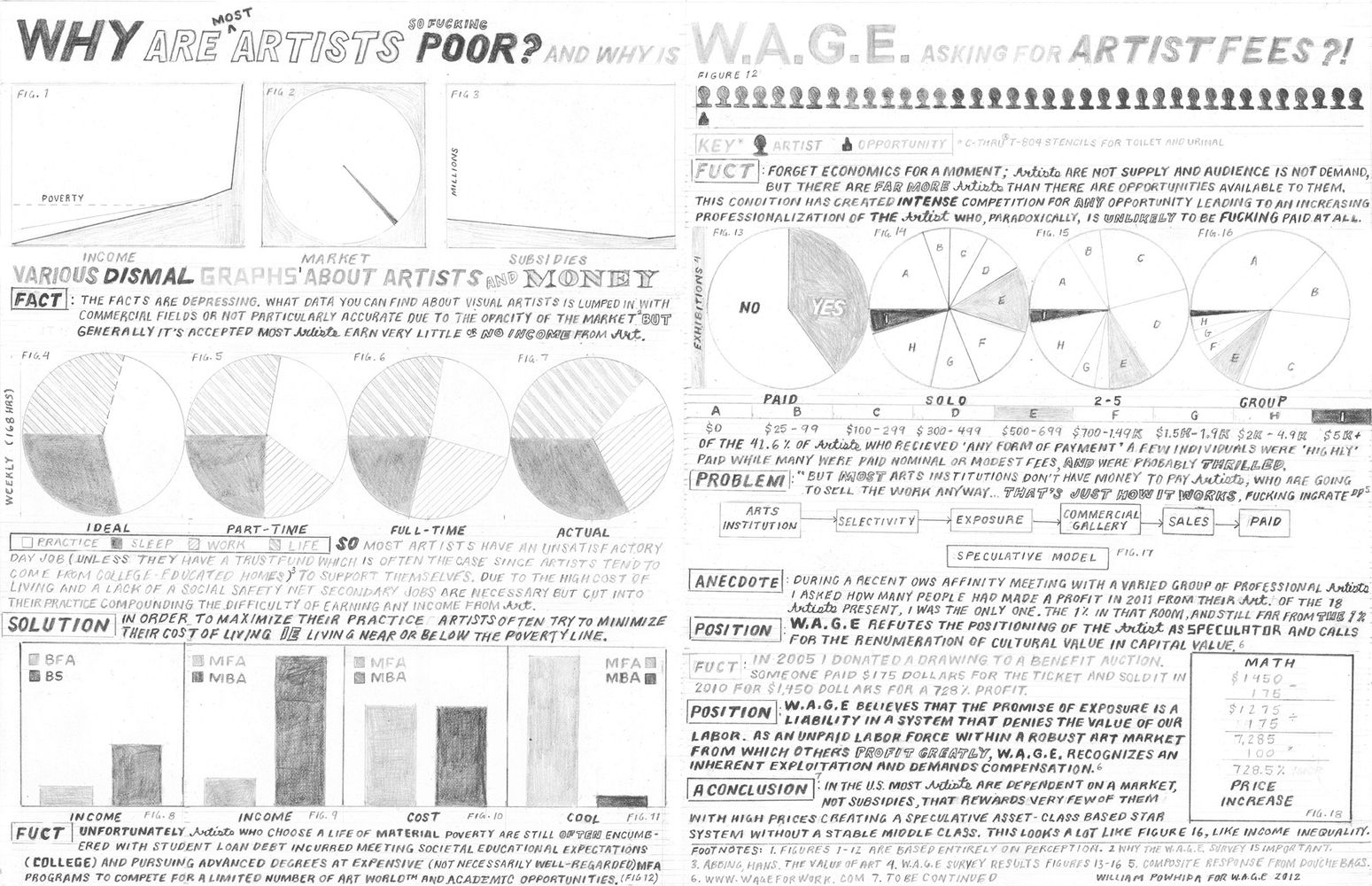W.A.G.E.: 2010 Artists Survey Results Presentation and Open Forum This Friday, April 20, 7pm Artists Space : Books & Talks 55 Walker Street_ 58% of artists who exhibited at a New York non-profit organization between 2005 and 2010 received no form of payment, compensation or reimbursement – including the coverage of any expenses._ - 2010 W.A.G.E. Artists Survey As part of the W.A.G.E. / Artists Space Research Partnership, Working Artists and the Greater Economy will release the 2010 W.A.G.E. Survey results and present their analysis. This survey gathered information from nearly 1000 visual and performing artists about their economic experiences working with non-profit arts organizations and museums in New York City between 2005-2010, and included specific questions about the receipt of artist fees as well as the coverage of expenses for exhibitions, screenings, lectures and performances at over 67 institutions throughout the 5 boroughs. The survey results present a vital and precise portrait of the predominant economic relationships between artists and institutions. W.A.G.E.’s Research Partnership with Artists Space is based in part on the need to compare such information with the particularities of institutional budgets. Accompanied by Alison Gerber, sociologist and PhD candidate at Yale’s Center for Cultural Sociology, W.A.G.E. will provide a visual presentation of the survey results, followed by a specific comparison of Artists Space’s honoraria payments to artists, speakers and performers between 2005 and 2010, to the existing fee schedule set by CARFAC (Canadian Artists Representation/Front Des Artistes Canadiens). This presentation will also introduce the principles of W.A.G.E. Certification, and the work being done to develop it through the Research Partnership. Free food by FEAST/Brooklyn and survey posters with artwork by William Powhida will be provided. Survey graphics designed by Common Space. For more on the W.A.G.E. and Artists Space partnership: www.artistsspace.org/aspace/programs/w-a-g-e-working-artists-and-the-greater-economy www.wageforwork.com
Seditions, opens Friday February 25th at the McKinney Avenue Contemporary in Dallas, Texas. I’ve included two new drawings as a point of comparison between the originals and the mechanical reproductions in the show. Images: _What Can The Art World Teach You? _Graphite, colored pencil, and watercolor on paper, 22" x 30", 2012_What Has The Art World Taught Me?, _Graphite, colored pencil, and watercolor on paper, 22" x 30", 2012
Griftopia. Graphite, watercolor, acrylic ink, and colored pencil on paper. 5’ x 10’. 2011. Courtesy of Postmasters Gallery. Private Collection.
Composite [Arts Magazine], No. 4 Doppelganger William Powhida: Infinite Regress, page 9
Photo credit: Craig Platt
POWHIDA
Marlborough Chelsea / July 27-August 12, 2011The directors of Marlborough Chelsea are pleased to announce POWHIDA, a site-specific project bythe eponymous artist opening Wednesday, July 27th. The exhibition will be on view through August12th.Utilizing the entire ground floor gallery, POWHIDA is the artist’s most ambitious installation to date.In keeping with his oeuvre, Powhida has taken his relationship with the art world as the very subjectof the exhibition, employing numerous historical departure points and creating a vast conceptualspectrum reflected in the diversity of the artist’s approaches to making art. These references span fromthe 19th-century French Romantic painters Delacroix and Gericault to participatory performance thatde-materializes the object.Like the artist himself, POWHIDA explores an array of contemporary socio-political and culturalissues germane to the artist’s role in society. In the vein of Arthur Dove’s The Critic, 1925, and AdReinhardt’s sardonic How to Look at Modern Art in America, 1946, POWHIDA unabashedly turns amirror on the idiosyncratic machinations of the industry, allowing an established international artist tolook at his role from the inside out.The artist’s reverence for Duchamp and Warhol is central to understanding POWHIDA as aninstallation of non-traditional art objects throughout the gallery; these objects signify a contextualshift from the merely functional to the purposely artistic. To signal this shift, the artist himself willbe physically present in the gallery operating as an autonomous artwork to further engage the viewer,building on the exhaustive performances pioneered by Vito Acconci, Stuart Brisely, and MarinaAbramovic.The artist and objects themselves are the very means with which POWHIDA will coalesce into adivergent, yet coterminous installation immersing the viewer in a manner similar to Oldenburg’s TheStore, 1961-62, the experiential amalgamations of Jason Rhoades, and more recently, Black Acid Co-Op,the functional meth lab created by Jonah Freeman and Justin Lowe installed at Deitch Projects, NewYork in 2009. While these installations required significant material alterations, POWHIDA strips theGallery to its essence, laying it bare.In the artist’s words, “The gallery is a world unto itself, a social space with a highly codified set ofrelationships having the formal beauty of a ballet. I will transform it, literally, choreographing eachmovement, each gesture with every interaction. No two viewers will have a similar experience in thegallery if I can help it. They may never see an art gallery the same way again.”POWHIDA is generously supported by Flavorpill, The Mondrian Soho and Pernod-Absinthe. A fullyillustrated digital catalogue will be available at the time of the exhibition.Marlborough Chelsea / International Public Art Ltd., 545 West 25th St, New York, NY 10001 t. 212.463.8634 f. 212.463.9658 chelsea@marlboroughgallery.com





